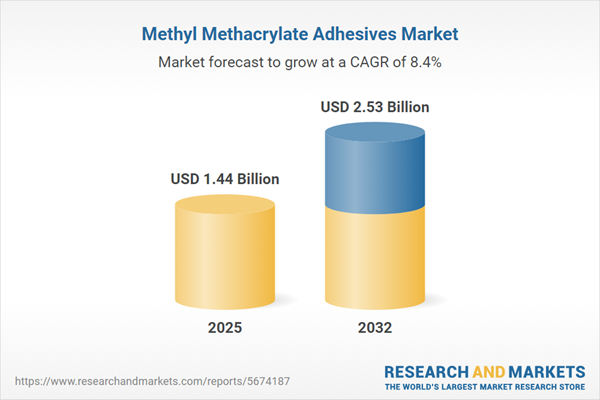Speak directly to the analyst to clarify any post sales queries you may have.
Methyl methacrylate adhesives are redefining quality and compliance standards for manufacturers responding to complex regulatory and performance requirements. This report delivers senior leaders essential, market-focused intelligence to optimize operational strategies, streamline sourcing, and remain agile amid evolving industry landscapes.
Market Snapshot: Methyl Methacrylate Adhesives Market
The methyl methacrylate adhesives market presents strong expansion, now valued at USD 1.33 billion in 2024 and set to reach USD 1.44 billion by 2025. With an anticipated CAGR of 8.36%, long-term projections signal the sector attaining a market size of USD 2.53 billion by 2032. Growth continues to accelerate as advanced applications gain traction across automotive, construction, electronics, and medical manufacturing verticals. Technology development is concentrated on emissions reduction and regulatory alignment, supported by an increasingly competitive landscape. In response, executive teams must ensure investment strategies are synchronized with ongoing market transformation and shifting compliance priorities.
Methyl Methacrylate Adhesives Market: Scope & Segmentation
This analysis offers in-depth strategic guidance, equipping senior leaders to identify risk drivers and growth opportunities by dissecting critical segments and operational priorities.
- Application Areas: Automotive manufacturing integrates adhesives in exterior panels and powertrain applications, while construction leverages them for flooring and paneling solutions. Consumer goods—including toys and appliances—benefit from efficient bonding, with electronics utilizing adhesives for telecom and computing devices. Industrial machinery, packaging processes, and medical products such as dental and surgical instruments all require adhesive technologies tailored to exacting standards. Understanding application-specific criteria is crucial for technology selection and compliance management.
- Formulation Types: Single-component and two-component systems define product customization, each impacting manufacturing throughput, safety protocols, and process optimization. These formulations offer tailored solutions for diverse production environments.
- Product Forms: Films, liquids, and pastes facilitate seamless integration into various assembly workflows. Choice of form directly influences application consistency and production agility.
- Cure Mechanisms: The market spans heat, room temperature, UV, and dual-cure systems. Each enables flexible process control and compatibility with distinct operational needs, promoting efficiency in dynamic manufacturing settings.
- Distribution Channels: Direct partnerships with OEMs and system integrators are complemented by indirect relationships via wholesalers, retailers, and e-commerce. This structure helps organizations match sourcing channels to requirements for volume and operational agility.
- Geographies Covered: Analysis includes Americas, Europe, Middle East, Africa, and Asia-Pacific. Every region presents distinct regulatory environments and logistical considerations, which play a role in go-to-market and procurement planning.
- Company Analysis: The competitive field encompasses established and emerging leaders such as Dow Inc., 3M Company, Arkema S.A., Evonik Industries AG, Sika AG, H.B. Fuller, Henkel, Illinois Tool Works, RPM International, and Ashland Global. The report benchmarks these players to support partnership and procurement decisions.
Key Takeaways for Senior Decision-Makers
- Breakthroughs in polymer chemistry are driving greater adhesive longevity and supporting stable viscosity, which strengthens compliance with technical demands in precision-driven sectors.
- Sustainable innovation efforts are advancing the adoption of bio-based and low-emission formulations to support heightened environmental mandates and new reporting standards.
- Quality control processes benefit from automation and digitalization, helping manufacturers minimize inconsistencies and streamline operations, particularly in globally distributed production.
- Advanced curing techniques and specialty monomers support the integration of lightweight and high-performance composites, meeting the efficiency objectives of sectors like transportation and aerospace.
- Shifts in supply chain strategy prioritize localized clusters and diversified supplier networks, fostering agile organizational responses to regulatory and market disruptions.
Tariff Impact: 2025 United States Tariff Developments
Forthcoming changes to tariffs on methyl methacrylate raw materials and finished products in the United States are elevating input expenses for import-reliant firms. To address these pressures, organizations are enhancing supply chain transparency, deepening collaborations with regional suppliers, and securing long-term partnerships. These approaches bolster business continuity and reduce exposure to shifting policy conditions.
Methodology & Data Sources
Research draws on direct interviews with key stakeholders such as formulation chemists, manufacturing engineers, and procurement and compliance experts. This primary data is triangulated with technical literature reviews, patent analysis, and global trade statistics, then validated by a sector specialist panel to ensure deep accuracy and relevance.
Why This Report Matters
- Empowers senior leadership to anticipate technical, compliance, and sourcing challenges using actionable intelligence grounded in the evolving methyl methacrylate adhesives market.
- Supports strategy development by clarifying regulatory tracking, operational flexibility, and opportunity identification across geographies and industrial applications.
- Enables organizations to reshape supply chains and procurement frameworks based on dynamic regional and sector-specific pressures.
Conclusion
Armed with actionable insights from this analysis, leaders can proactively capture emerging opportunities and align strategic planning to the changing demands of the adhesives marketplace.
Additional Product Information:
- Purchase of this report includes 1 year online access with quarterly updates.
- This report can be updated on request. Please contact our Customer Experience team using the Ask a Question widget on our website.
Table of Contents
3. Executive Summary
4. Market Overview
7. Cumulative Impact of Artificial Intelligence 2025
List of Figures
Samples

LOADING...
Companies Mentioned
The key companies profiled in this Methyl Methacrylate Adhesives market report include:- Dow Inc.
- 3M Company
- Arkema S.A.
- Evonik Industries AG
- Sika AG
- H.B. Fuller Company
- Henkel AG & Co. KGaA
- Illinois Tool Works Inc.
- RPM International Inc.
- Ashland Global Holdings Inc.
Table Information
| Report Attribute | Details |
|---|---|
| No. of Pages | 180 |
| Published | October 2025 |
| Forecast Period | 2025 - 2032 |
| Estimated Market Value ( USD | $ 1.44 Billion |
| Forecasted Market Value ( USD | $ 2.53 Billion |
| Compound Annual Growth Rate | 8.3% |
| Regions Covered | Global |
| No. of Companies Mentioned | 11 |









